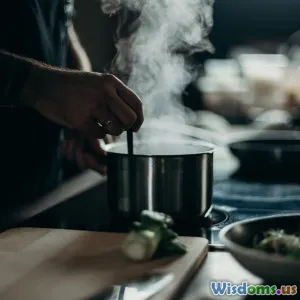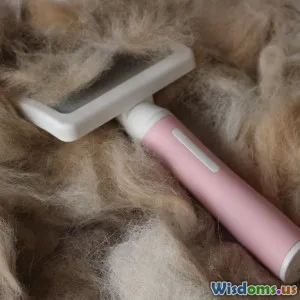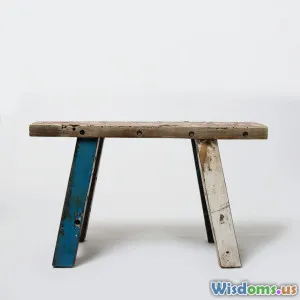
Essential Kitchen Tools for Beginners
8 min read Discover the essential kitchen tools every beginner needs to cook confidently and efficiently. (0 Reviews)
Essential Kitchen Tools for Beginners
Embarking on the culinary journey can be as thrilling as it is intimidating. For beginners, the kitchen often feels like a battleground lined with mysterious gadgets and unfamiliar gadgets. However, arming yourself with the right tools throws down the gauntlet against confusion and inefficiency. Getting the essential kitchen tools not only boosts your confidence but also transforms cooking from a daunting task into an enjoyable creative endeavor.
Why Choosing the Right Tools Matters
Imagine trying to slice a tomato with a dull butter knife or scramble eggs in a pan that never distributes heat evenly. Frustration is bound to set in. According to a 2019 study by the National Kitchen and Bath Association, well-equipped kitchens encourage more frequent cooking and healthier eating habits. Having the right equipment streamlines meal preparation, improves safety, and enhances your overall culinary outcomes.
Top Must-Have Kitchen Tools for Beginners
1. Chef’s Knife
Arguably the most important tool in your arsenal, a good chef’s knife offers versatility with its broad and sharp blade. It allows you to chop vegetables, slice meats, and mince herbs efficiently. Experts recommend starting with an 8-inch chef’s knife made from high-carbon stainless steel for balance and durability. Renowned chef Julia Child famously stated, "A good knife has a kind of intuition. It’s almost like an extension of the hand."
2. Cutting Board
Protect your counters and maintain knife sharpness by using a quality cutting board. Wooden boards are gentle on knives but require care, while plastic boards are dishwasher safe and more convenient for raw meat. Having multiple boards assigned to different food groups helps prevent cross-contamination, a crucial practice for food safety.
3. Measuring Cups and Spoons
Precision is key in cooking and even more critical in baking. Investing in an accurate set of measuring cups and spoons ensures your recipes turn out as intended. Opt for stainless steel sets as they are not only durable but also easy to clean. Labels etched into the metal won't wear off over time, making them a lasting tool in your kitchen.
4. Mixing Bowls
A versatile set of mixing bowls, preferably in stainless steel or glass, is essential for combining ingredients, marinating, and even serving. Glass bowls allow you to monitor contents without lifting the lid, and they're microwave-safe, adding extra functionality.
5. Nonstick Skillet and Saucepan
For beginners, a good nonstick skillet—around 10 inches in diameter—is perfect for frying eggs, sautéing vegetables, and cooking delicate proteins like fish. Pair this with a medium-sized saucepan to boil pasta, make sauces, or reheat leftovers efficiently. The current market offers quality nonstick options free of harmful chemicals like PFOA, combining safety and convenience.
6. Wooden Spoon and Spatula
Wooden spoons provide a sturdy and natural utensil for stirring soups and sauces without scratching cookware. A heat-resistant nylon or silicone spatula is equally indispensable for flipping pancakes or folding batter. Combined, these tools prevent damaging expensive cookware coatings.
7. Colander
Efficiently draining pasta, rinsing fruits and vegetables, or washing grains requires a reliable colander. Stainless steel or silicone collapsible models can fit smaller kitchens and ease storage—prioritize sturdiness and size based on your usual cooking volumes.
8. Baking Sheet and Oven Mitts
For versatile baking tasks such as roasting vegetables, baking cookies, or toasting nuts, a durable baking sheet is essential. Complement your baking activities with well-padded, heat-proof oven mitts to ensure safety when handling hot pans and trays.
Additional Handy Tools Worth Considering
Once you master basics, you might find the following tools advantageous:
-
Immersion Blender: Perfect for soups and smoothies, offering quick blending without the mess.
-
Food Storage Containers: Keep leftovers fresh and organize your fridge efficiently.
-
Digital Kitchen Timer: Accurate time management can improve cooking results.
Insights from New Cooks and Professionals
New cooks often express feeling overwhelmed by the plethora of kitchen gadgets available. Chef Thomas Keller advises, "Start with tools that help you learn technique, not gadgets that do the work for you. A solid knife and pan teach foundational skills." This approach simplifies learning and improves technique.
On the other hand, seasoned home cooks emphasize quality over quantity. According to a survey conducted by Cook’s Illustrated, cooks who invested in essential quality tools reported a 40% increase in cooking satisfaction and were more likely to experiment with new recipes.
Budgeting Tips for Beginners
Building your kitchen toolset doesn’t mean breaking the bank. Start with essentials and choose mid-range quality to balance durability and cost. Look out for combo sets or discounts at stores during sales events like Black Friday. Alternatively, secondhand cookware from reliable sources can be a fantastic way to acquire good-quality tools inexpensively.
Conclusion
Equipping your kitchen with the essential tools for beginners paves the way for success, allowing you to explore and enjoy the art of cooking confidently. From a sharp chef’s knife that effortlessly glides through ingredients to practical cookware for versatile meal preparation, these essentials are the foundation of a well-functioning kitchen. Investing in quality and understanding the right tool’s purpose can turn daily meal prep into an enjoyable, fulfilling activity. So, gear up wisely and savor the journey from novice cook to confident culinary creator.
Ready to start cooking? Pick up your essential kitchen tools today and elevate every meal with ease and confidence!
Rate the Post
User Reviews
Popular Posts





















